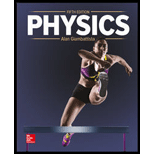
(a)
The weight of beach ball including the air inside it.
(a)
Answer to Problem 102P
The weight of beach ball is
Explanation of Solution
Radius of ball is
Write the equation for the weight of ball with air inside it.
Here,
Conclusion:
Substitute
Therefore, the weight is
(b)
The buoyant force on beach ball.
(b)
Answer to Problem 102P
The buoyant force is
Explanation of Solution
Radius of ball is
Write the equation for buoyant force on each ball.
Here,
Conclusion:
Substitute
Buoyant force will acts in opposite direction of weight. That is directed upwards.
Therefore, the buoyant force is
(c)
The acceleration of ball at the top of its path.
(c)
Answer to Problem 102P
The acceleration is
Explanation of Solution
Radius of ball is
The free body diagram is shown below in figure 1.

Write the equation net force on the ball.
Here,
Rewrite the above equation in terms of
Write the equation to find
Rewrite the equation for
Conclusion:
Substitute
Negative value indicates that the acceleration is directed in downward direction.
Therefore, the acceleration is
Want to see more full solutions like this?
Chapter 9 Solutions
Physics
 College PhysicsPhysicsISBN:9781305952300Author:Raymond A. Serway, Chris VuillePublisher:Cengage Learning
College PhysicsPhysicsISBN:9781305952300Author:Raymond A. Serway, Chris VuillePublisher:Cengage Learning University Physics (14th Edition)PhysicsISBN:9780133969290Author:Hugh D. Young, Roger A. FreedmanPublisher:PEARSON
University Physics (14th Edition)PhysicsISBN:9780133969290Author:Hugh D. Young, Roger A. FreedmanPublisher:PEARSON Introduction To Quantum MechanicsPhysicsISBN:9781107189638Author:Griffiths, David J., Schroeter, Darrell F.Publisher:Cambridge University Press
Introduction To Quantum MechanicsPhysicsISBN:9781107189638Author:Griffiths, David J., Schroeter, Darrell F.Publisher:Cambridge University Press Physics for Scientists and EngineersPhysicsISBN:9781337553278Author:Raymond A. Serway, John W. JewettPublisher:Cengage Learning
Physics for Scientists and EngineersPhysicsISBN:9781337553278Author:Raymond A. Serway, John W. JewettPublisher:Cengage Learning Lecture- Tutorials for Introductory AstronomyPhysicsISBN:9780321820464Author:Edward E. Prather, Tim P. Slater, Jeff P. Adams, Gina BrissendenPublisher:Addison-Wesley
Lecture- Tutorials for Introductory AstronomyPhysicsISBN:9780321820464Author:Edward E. Prather, Tim P. Slater, Jeff P. Adams, Gina BrissendenPublisher:Addison-Wesley College Physics: A Strategic Approach (4th Editio...PhysicsISBN:9780134609034Author:Randall D. Knight (Professor Emeritus), Brian Jones, Stuart FieldPublisher:PEARSON
College Physics: A Strategic Approach (4th Editio...PhysicsISBN:9780134609034Author:Randall D. Knight (Professor Emeritus), Brian Jones, Stuart FieldPublisher:PEARSON





